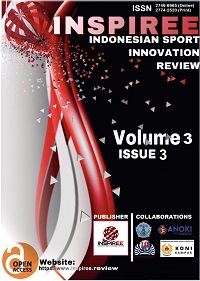The Athletic Identity and Level of Optimism of Selected University of Santo Tomas Institute Student-Athletes during the Covid-19 Pandemic
DOI:
https://doi.org/10.53905/inspiree.v3i03.90Keywords:
Athletic identity, Level of optimism, COVID-19, Student-athletesAbstract
The purpose of the study. The COVID-19 pandemic has impacted sporting events, which led to the cancellation of games and student-athletes being isolated at home and conducting their training online. The study looked at how student-athletes view themselves and their levels of optimism before and during the pandemic.
Materials and methods. The study is a descriptive quantitative research that adapted the constructs of the Athletic Identity Measurement Scale (AIMS) and Revised Life Orientation Test (LOT-R). Slovin’s formula and stratified random sampling were used to select the respondents. Google Form was used to gather data on the 154 UST-IPEA student-athletes. For data analysis, Microsoft Data Analysis ToolPak was used as statistical software.
Results. The results show that the factors of Level of Optimism, namely: Gender, Typology of Sports, and Competitive Level, do not affect the student-athletes Level of Optimism before and during the COVID-19 pandemic. Meanwhile, the factors of Athletic Identity, namely: Gender, Year Level, and Socioeconomic Status, do not affect the student-athletes’ Athletic Identity before the COVID-19 pandemic. However, one factor that affects the student-athletes’ Athletic Identity during the COVID-19 pandemic is the Typology of Sports. To sum up, the Athletic Identity and Level of Optimism possess a weak correlation.
Conclusions. . Based on the results of the study, it is concluded to regularly monitor the student-athletes’ Athletic Identity and Level of Optimism by taking the Athletic Identity Measurement Scale (AIMS) by Brewer & Cornelius (2001) and Revised Life Orientation Test (LOT-R)).
References
Anderson, C.B. (2004). Athletic identity and its relation to exercise behavior: Scale development and initial validation. Journal of Sport and Exercise Psychology, 26, 3956. https://www.researchgate.net/publication/283764349_Athletic_Identity_and_Its_Relation_to_Exercise_Behavior_Scale_Development_and_Initial_Validation
Bosjlie, S. (2020) Student Athletes Covid-19 Impact. Achieveptonline.com. https://www.achieveptonline.com/blog/student-athletes-covid-19-impact
Brewer, B.W., Van Raalte, J.L., and Linder, D.E. (1993). Athletic identity: Hercules’ muscles or Achilles’ heel? International Journal of Sport Psychology, 24(2), 237-254. https://psycnet.apa.org/record/1994-03969-001
Brewer, M. B., & Roccas, S. (2001). Individual values, social identity, and optimal distinctiveness. In C. Sedikides & M. B. Brewer (Eds.), Individual self, relational self, collective self(pp. 219–237). Philadelphia, PA: Psychology Press/Taylor & Francis
Brewer, B.W., Van Raalte, J.L., and Linder, D.E. (1993). Athletic identity: Hercules’ muscles or Achilles’ heel? International Journal of Sport Psychology, 24(2), 237-254. https://psycnet.apa.org/record/1994-03969-001
Brewer, M. B., & Roccas, S. (2001). Individual values, social identity, and optimal distinctiveness. In C. Sedikides & M. B. Brewer (Eds.), Individual self, relational self, collective self(pp. 219–237). Philadelphia, PA: Psychology Press/Taylor & Francis
Costa, S., Santi, G., Di Fronso, S., Montesano, C., Di Gruttola, F., Ciof, E. G., Morgilli, L., & Bertollo, M. (2020). Athletes and adversities: athletic identity and emotional regulation in time of COVID‐19. Sport Sciences for Health 16:609–618. https://doi.org/10.1007/s11332-020-00677-9
Harter, S. (1990). Causes, correlates, and the functional role of global self-worth: A life-span perspective. In R. J. Sternberg & J. Kolligian, Jr. (Eds.), Competence considered (pp. 67–97). Yale University Press.
Liu, I. (2020) The Impact of COVID-19 Pandemic on High Performance Secondary School Student-Athletes. The Sport Journal. https://thesportjournal.org/article/the-impact-of-covid-19-pandemic-on-high-performance-secondary-school-student-athletes/
Luthans, F.; Luthans, K.W.; Luthans, B.C. (2004). Positive psychological capital: Beyond human and social capital. Bus. Horiz.
Mills, A. (2019) A Day in the Life of a Student-Athlete. Michigan Tech. https://www.mtu.edu/magazine/2019-1/stories/student-athlete/
Pérez, C. L., Salamanca, M. V., Castañeda, I. A., Soto, P. B., & Vanegas, I. J. (2014). What makes us optimistic?: Psychosocial factors as predictors of dispositional optimism in young people. TerapiaPsicológica, 32(2), 153–164. https://doi.org/10.4067/S0718-48082014000200008
Rosenberg, M. (1989). Society and the adolescent self-image. Revised edition. Middletown, CT: Wesleyan University Press.
Sammarone, O. (2017) Finding Balance in Life As A College Athlete. Athlete Network. https://an.athletenetwork.com/blog/finding-balance-in-life-as-a-college-athlete?fbclid=IwAR0wHjrS3ZQDM2g7aQw9mrF7TQ5CLAgFr4JJ3w3ed4M77UZFPusVYec4KlA
Schemer, M. F. & Carver, C. S. (1988). A model of behavioral self-regulation: Translating intention into action. In L. Berkowits (Ed). Advances in experimental social psychology (Vol 21, pp. 303-346) San Diego, CA: Academic Press
Snyder, C. R., Irving, L. M., & Anderson, J. R. (1991). Hope and health. In C. R. Snyder & D. R. Forsyth (Eds.), Handbook of social and clinical psychology: The health perspective (pp. 285–305). Pergamon Press.
Wong, A.Y, et.al. (2020) Impact of the COVID-19 pandemic on sports and exercise.ScienceDirect. https://www.sciencedirect.com/science/article/pii/S2214687320300674?fbclid=IwAR2DvFxt-wH-7vfOAIqY2L5q-aftOwrdblv96LrdW-qX_q9mBgujsd7LxcQ
Downloads
Published
Issue
Section
License
Copyright (c) 2022 Clinyl Mae Chuateco, Dominic Cervantes, Daisy Grace Lipasana, Anjelica Devi Mosqueda, Jaron Requinton, Olivia Dimatulac

This work is licensed under a Creative Commons Attribution-ShareAlike 4.0 International License.













